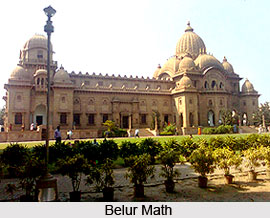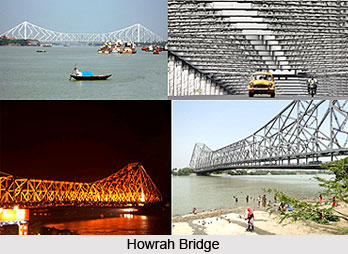 Tourism in Howrah district is replete with visits to places of historical and religious. These various places located in the district of Howrah are among the most visited places in all of West Bengal. Once known as the `Manchester of Bengal`, the district is home to a number of tourist attractions such as the Howrah Bridge, the Botanical gardens, Belur math etc. Some of the most visited places of tourism in Howrah district are discussed below.
Tourism in Howrah district is replete with visits to places of historical and religious. These various places located in the district of Howrah are among the most visited places in all of West Bengal. Once known as the `Manchester of Bengal`, the district is home to a number of tourist attractions such as the Howrah Bridge, the Botanical gardens, Belur math etc. Some of the most visited places of tourism in Howrah district are discussed below.
Leisure tourism in Howrah district
Of the various places of tourist interest located in the district of Howrah, the Howrah Bridge or Rabindru Setu is the most famous. The old Howrah Bridge was opened in 1874 and handed over to the Port Commissioners who managed and maintained it. It was designed by the late Sir Bradford Leslie. It extended over a total length of 1528 feet between centres of abutments and provided a 48 feet roadway and two 7 feet footways.
The most novel feature was the removable section which when floated out gave a 200 feet clear opening, with a head room of 22 feet, were also provided for smaller crafts. The adjusting ways or shore spans, one at each end of the bridge, consisted of three 160` feet long bow string girders.The traffic between commercial Kolkata and industrial Howrah having enormously increased during the first quarter of the 20th Century, the old bridge was quite insufficient and it was decided to build a new one. The shifting mode of the Hooghly River was dangerous for either a cantilever or a suspension bridge and hence a bridge was designed as a sort of combination of the both. It is however known as and reputed as a cantilever bridge and is the third largest bridge of its kind in the World having an over-all length of 2150 feet with a single span of 1500 feet.
Howrah Bridge
The new Howrah Bridge was designed by Rendell, Palmer and Tritton, consulting Engineers. It took 8 years to complete the bridge and 26,500 tons of steel including 18,200 tons of high tensile quality were used. The total cost of construction of the land and all ancillary works, amounted to Rs. 3.33 crores. It is interesting to note that the bridge expands about 4.8 inches during the heat of the day and contracts an equal length in the cool of the night. Another peculiarity of the bridge is that it bends over slightly in strong winds. The framework has also been built to withstand earth-quakes, as Calcutta lies in a seismic zone. The height of the Bridge at the supporting towers on the both ends is 300 feet. Each tower has a constant width of 11 feet. The entire structure is laid on main piers of re-enforced concrete monoliths with steel ceiling edges. The piers are among the largest in the world. The monoliths and grinders on the Kolkata side are 103 feet deep and on the Howrah side it is 88 feet deep. These monoliths are the heaviest in the world. One can have a bird`s eye view of Howrah Station and glimpses of the cities of Kolkata and Howrah along the banks of the Hoogly River standing in the middle of the bridge.
Second Hooghly Bridge
The Second Hooghly Bridge or Vidyasagar Setu is another landmark spot in Howrah. It opened to traffic in 1922 and is one of the finest products of modern technology and architecture. It is intricately connected with the cities of Kolkata and Howrah by a series of over-bridges and situated at a distance of 1.5 k.m. southwards of Rabinrda Setu.It is erected on only four pillars and hung on 121 number of iron ropes. The bridge is 458 metres long and 115 metres wide. One can have a glimpse of a large part of Kolkata standing in the middle of the bridge. The beauty of the bridge and its background is largely utilized by the Film Industries of India for shooting purposes.
Tourism in Howrah district would be incomplete without a mention of the Howrah station. Developed towards the early part of the twentieth century, it has become one of the most important points of transit for passengers as well as the movement of goods in the country. The station building completed a 100 years in 2006. Howrah is the terminus of the first Indian Railway system namely East Indian Railways. A survey for the East Indian Railway was taken up in 1845 and construction began in 1851. The section of the Railways, a Broad gauge railway was opened in 1854 from Howrah to Hooghly. After construction of the first Howrah Bridge in 1874, the Howrah Station was remodeled and improved. Howrah station has now a large imposing building facing the river with clock Tower and twenty long platforms for the passenger trains and three for the goods trains.
Botanic Gardens
 The Indian Botanic Gardens are a much visited place by both tourists and locals alike. Previoulsy known as the Royal Botanic Garden, it lies along the banks of the river Hooghly. It covers a total area of 285.05 acres of land. The Botanical gardens adjoin the compound of the Shibpur engineering college on the south. This green belt is considered to be the lungs of the highly industrial and urbanized city of Howrah. The greatest attraction of the garden is the Great Banyan Tree. The size of the tree is so huge that it resembles more of a forest than a single tree. The tree has sent down innumerable roots from its branches vertically to the ground and the roots have grown thick and stout to bear the appearance of having many trunks. The striking development of the aerial roots from the branches is the peculiarity of the Banyan tree. Besides the great Banyan Tree, there is a fair collection of rare indigenous and exotic plants, beautiful Amazon lilies, climbing plants, varieties of palm, delicate orchids and all sorts of large trees - mahogany, teak, walnut etc. Also found here is a nursery (not open to the public), a conservatory, a palm house, a Herbarium and an Orchid Conservatory. There are certain monuments and buildings which are also found in the Botanic gardens. These are - Wallich`s monument, Kyds` Monument, Griffiths Monument, Jack`s Monument, Kurze`s monuments etc.
The Indian Botanic Gardens are a much visited place by both tourists and locals alike. Previoulsy known as the Royal Botanic Garden, it lies along the banks of the river Hooghly. It covers a total area of 285.05 acres of land. The Botanical gardens adjoin the compound of the Shibpur engineering college on the south. This green belt is considered to be the lungs of the highly industrial and urbanized city of Howrah. The greatest attraction of the garden is the Great Banyan Tree. The size of the tree is so huge that it resembles more of a forest than a single tree. The tree has sent down innumerable roots from its branches vertically to the ground and the roots have grown thick and stout to bear the appearance of having many trunks. The striking development of the aerial roots from the branches is the peculiarity of the Banyan tree. Besides the great Banyan Tree, there is a fair collection of rare indigenous and exotic plants, beautiful Amazon lilies, climbing plants, varieties of palm, delicate orchids and all sorts of large trees - mahogany, teak, walnut etc. Also found here is a nursery (not open to the public), a conservatory, a palm house, a Herbarium and an Orchid Conservatory. There are certain monuments and buildings which are also found in the Botanic gardens. These are - Wallich`s monument, Kyds` Monument, Griffiths Monument, Jack`s Monument, Kurze`s monuments etc.
Panitras-Samtaber
Panitras-Samtaber is the home of the immortal Bengali novelist Sri Sarat Chandra Chattterjee. Though he was a writer of Bengali literature, his great novels and short stories dealing in human emotions are translated in almost all major languages of India. His two-storied dwelling house is situated at Panitras or Samtaber village on the bank of the Rupnarayan River in a sort of perfect lonely village atmosphere of Bengal. The building is now preserved as a museum where mementoes of Saratbabu like table, chair, chappals, stick, bed, writing tables etc are kept, apart from his works (books), some manuscripts and personal letters. Saratbabu spent twelve years (1926-1938) of his literary life in this place before permanently settling at Kolkata. During this period he created some of his finest stories and novels such as Abagir Swarga, Bamuner Meye, Palli Samaj, Ramer Sumati, Mahesh, Srikanta(4th part).
Bengal Engineering College
The Bengal Engineering College at Shibpur is a premier Engineering College in the state and one of the best engineering colleges in the country. It is situated on the banks of the River Hooghly at the south-eastern border of the town and the north of the Indian Botanic Garden. The site, comprised of about 50 acres of land, was originally included within the compound of Indian Botanic Garden and selected by Bishop Middleton, the first Bishop of Kolkata for Bishop`s College. The main building of the Engineering College - a Gothic structure, was also erected for the old Bishops` College. The land comprising 62 Bighas was presented by the Marquis of Hastings and money was funded by the Foreign Bible Society and the Church Missionary Society. The foundation stone was laid in 1820 and the college was opened in 1824. The college is upgraded to the status of a Deemed University in the recent past with facilities of learning of almost all the trades of engineering.
Pilgrimage Tourism in Howrah district
Belur Math is situated just outside the boundary of Howrah Municipal Corporation on the north and stands on the West Bank of the river Hooghly. It was founded in 1897 by Swami Vivekananda, the great savant of India, and other disciples of Sri Ramkrishna Paramhansa, who is regarded by the Hindus as an incarnation of God and occupies a place of great honour amongst the religious leaders of the world. A magnificent temple has been built at a great cost by the munificence of two pious American ladies, Miss Helen Rubel and Mrs Auna Worcester. The breadth of the shrine is 100 ft and its length, including the prayer hall, is 233 ft. On a marble pedestal in the shrine is a marble statute of Sri Ramkrishna in his familiar Asana. The prayer hall is 152 ft. long, 72 ft. wide and 48 ft. high. The math is the headquarters of the Ramkrishna Mission, a society established for the propagation of the orthodox Hindu faith chastened with modern outlook. There is also a large Museum inside the Math depicting the lives of Sri Ramkrishna and his close disciples. The temple and the Math is visited by countless people, most of whom are religiously inclined, to celebrate the birthday anniversary of Sri Ramkrishna (18th February 1836) in February when a fair is held there. The place also attracts large number of visitors from Kolkata and abroad every day, especially on Sundays and holidays.






